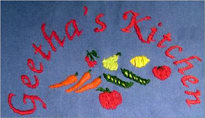These pizza-like snacks are healthy as well as tasty! It is truly a happy international amalgam with the oriental Tofu, Italian Parmesan cheese, American Chili Powder, and the Indian Turmeric and Sambar Powder. Who says the East and West cannot meet? Actually the true quote from Rudyard Kipling is :
The various ingredients may originate in different parts of the Earth but come together congenially to make this dish.
Although I have been making these spicy toasts for a long time, I wasn't content until this recipe evolved through trials and time. Now this recipe is not only nutrient-rich and low in fats, but also quite delicious.
I make the topping ahead of time and keep it in the refrigerator. Once the topping is made, it takes a jiffy to turn out great tasting snacks. They are great for breakfast or as an accompaniment with soup or salad for a light meal. They are just as delicious but with hardly any carbohydrates if made with hollow vegetables as suggested in the variations option. Enjoy!
Makes enough topping for 12 pita breads. Allow 1/2 pita bread or one English muffin per person for an appetizer serving. I use low fat cheese and whole grain breads for maximum nutrition and taste.
**Update - 2020**
The East-West Spicy Spread maybe prepared without the cheeses and zucchini; and instead of tofu, vegan mayo maybe used. And green olives work too, stuffed type or not. The rest is the same - spread on any bread or even cooked potatoes and bake until bubbly and browned a little. Seriously yummy!!
Ingredients:
12 Whole Wheat Pita breads OR English muffins, bread, baguettes, etc
For the Topping:
1 Container Tofu, any type 14 oz.
1/2 tsp Turmeric
1 Tbsp Chili Powder (American Type - mixture of chilies, cumin, garlic and oregano)
1 Tbsp Sambar Powder
1 small bunch Green Onions, finely sliced
1 small can Black Olives, chopped
1 cup grated Parmesan Cheese, 4 oz.
1 cup grated low fat Mozzarella, Jack, or Cheddar Cheese (or a blend), 4 oz.
1/2 cup Fresh Cilantro, chopped
1 medium Zucchini, shredded
Method:
Mash the tofu well. Combine all the ingredients for the topping in a bowl and mix thoroughly. Divide the topping among 12 whole wheat pita breads. Spread to the edges, place in a 400 degree F oven or toaster oven and bake until topping is bubbly and lightly browned. Other breads such as English muffin halves, or halved baguettes may be used instead of the pita breads. Remove and slice into wedges or bite sized pieces. Serve hot.
Enjoy!!
Nutrition Information: Each serving of 1/4 Whole Wheat pita bread prepared with the above topping contains: 70 Calories, 8.5 g Total Carbohydrates, 4.25 g Protein, 2.5 g Fats plus loads of vitamins and minerals
Variations: The tofu topping can be used to fill vegetables such as hollowed zucchini boats, quartered bell peppers, etc (instead of being spread on bread) and baked until hot and lightly browned and served as appetizers or side dishes.









